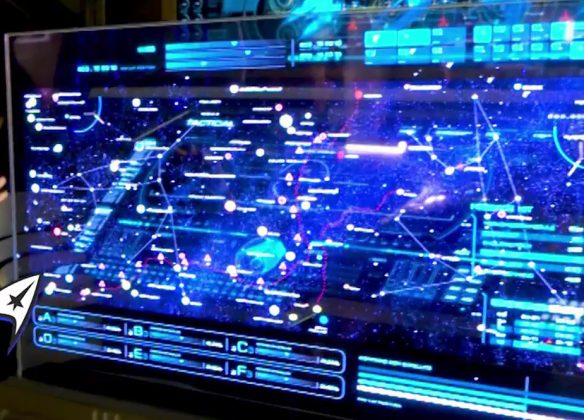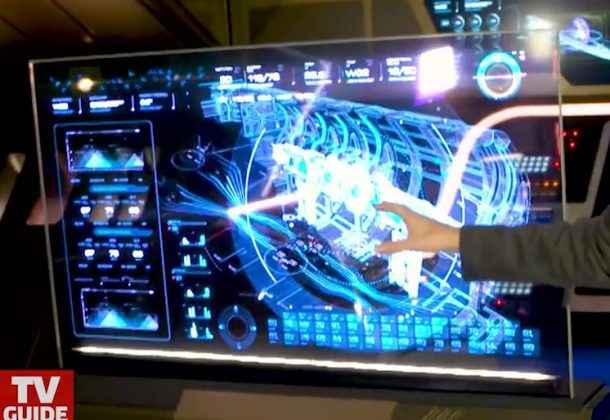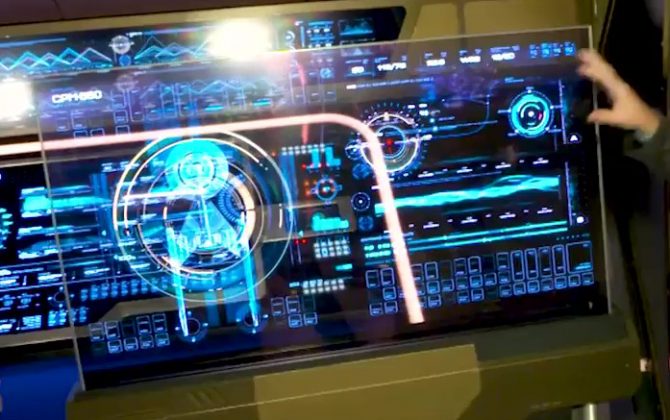In late August, press from around the world were able to beam up to the Star Trek: Discovery sets in Toronto, and several reports from that visit have begun to debut online as we are now officially two weeks away from having seen the first episode of the upcoming series.
First up, TV Guide’s Alexander Zalben got to shoot a bit of video on the USS Discovery bridge set, and here’s a look at the real-life transparent displays, our first great view at how these innovative set designs rely more on practical effects than digital compositing.
Here’s a few caps of those incredible displays:
As part of their on-set interviews, TV Guide learned a few secrets not yet revealed from the series, such as:
- Captain Lorca (Jason Isaacs) has a standing desk in his ready room, rather than the traditional chair-and-desk configuration seen in previous captains’ offices
- Viewscreen communication has been upgraded to holographic displays in the series, to allow “two actors in a a room, playing a scene” – per producer Aaron Harberts
- Michael Burnham (Sonequa Martin-Green) will be primarily based out of the USS Discovery’s engineering section below decks, paired up with Tilly (Mary Wiseman) and Stamets (Anthony Rapp) for a key part of the storyline — a section of the ship that also features a mystery room and a strange “reaction cube,” both of which details about are being kept under wraps.
- Lorca has a secure-access room referred to by producers as “Lorca’s menagerie,” without offering any more details on this tantalizing space aboard ship
- A bottle of Chateau Picard wine has a spot in Captain Georgiou’s (Michelle Yeoh) Shenzhou ready room
In addition, several of the cast speak in yet another new interview video focusing on some of the more negative ‘anti-diversity’ feedback some people have expressed towards the show.
* * *
IGN also had an opportunity to visit the Discovery sets, and IGN’s Scott Collura sat down with producer Aaron Harberts to talk about the Klingon War, concerns with Star Trek: Enterprise-era canon, and faith in the Final Frontier.
Related! What I saw on the amazing set of #StarTrekDiscovery. Listen to #TR3! https://t.co/Gdrx8L49o6 pic.twitter.com/56KGysOros
— Scott Collura (@ScottCollura) September 11, 2017
On the burgeoning Klingon War that impacts the first season of the show, Harberts spoke about how the United Federation of Planets approaches such a conflict.
[The] question becomes… how do you end a war, how do you find peace, without crushing and annihilating your opponent? And to me, that’s the Star Trek way of doing a war story. It’s not the Federation annihilates the Klingons. It’s Starfleet and the Federation figure out a way to truly make peace.
Now we know that when TOS picks up, that peace doesn’t last. But we have to find peace in our time, in our slice of the Star Trek pie. That’s a really important thing to us, and we’re going to offer up a way that these two warring factions come to an understanding.
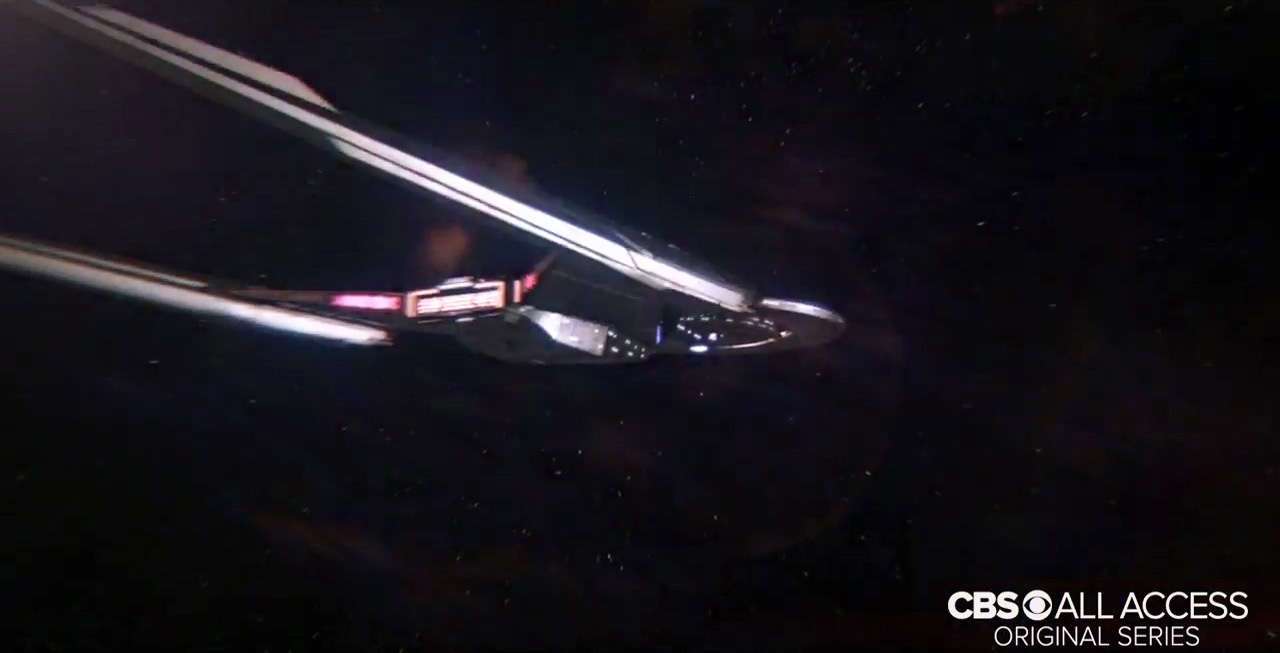
“Anyone remember when we used to be explorers?” This quote from Captain Picard in Star Trek: Insurrection seems to apply to the crew of the Discovery, revealed now to actually be a science vessel during times of peace:
These Starfleet officers who find themselves in war are very quick to remind the audience that they didn’t sign up to do that. That they are explorers first, that they are diplomats first… in fact, Discovery is a science vessel that has been conscripted for the war effort.
…
[Stamets’] methods and life’s work is now being converted to be used for the war effort, and that bothers him greatly.
Much ado has been made about the time period Discovery is placed in — a year after “The Cage,” and about a decade before Captain Kirk takes command of the USS Enterprise — and Harberts himself expressed a bit of frustration about how the tales told during the most recent Trek television series, Star Trek: Enterprise, impacts their storytelling abilities.
The only thing that’s felt limiting is the era and time that we are telling our story, because you’ve got ‘Enterprise’…
I find that ‘Enterprise actually’ has made things the most limiting, because of some of the retconning that they did in certain ways. And we consider Enterprise canon as well in certain ways, and just as valid, and we’re always trying to kind of make sure that that’s taken into consideration.

Finally, Harberts took on the “overblown” report that from last month that Discovery characters “can’t say ‘God'” — emphasizing that is strictly a character note for Gabriel Lorca (Isaacs), and not for the Trek universe as a whole.
You will come to understand why [Lorca] has faith — or doesn’t have faith — is of vital importance. We had no interest in killing God, you know, and by God I mean anyone’s God.
So the fact of the matter is I don’t think religion is going anywhere. Polls may say differently, but I think faith and hope and spirituality, whatever you may think that is, we’re carrying that into the future. We have to.
I think that the world is, and our Star Trek universe, is open to any and all belief systems.
…
I want to actually do some storylines about [faith]…. Let’s talk about what place it has in the future. Let’s talk about what it makes people do. Let’s talk about encountering new ones.
* * *
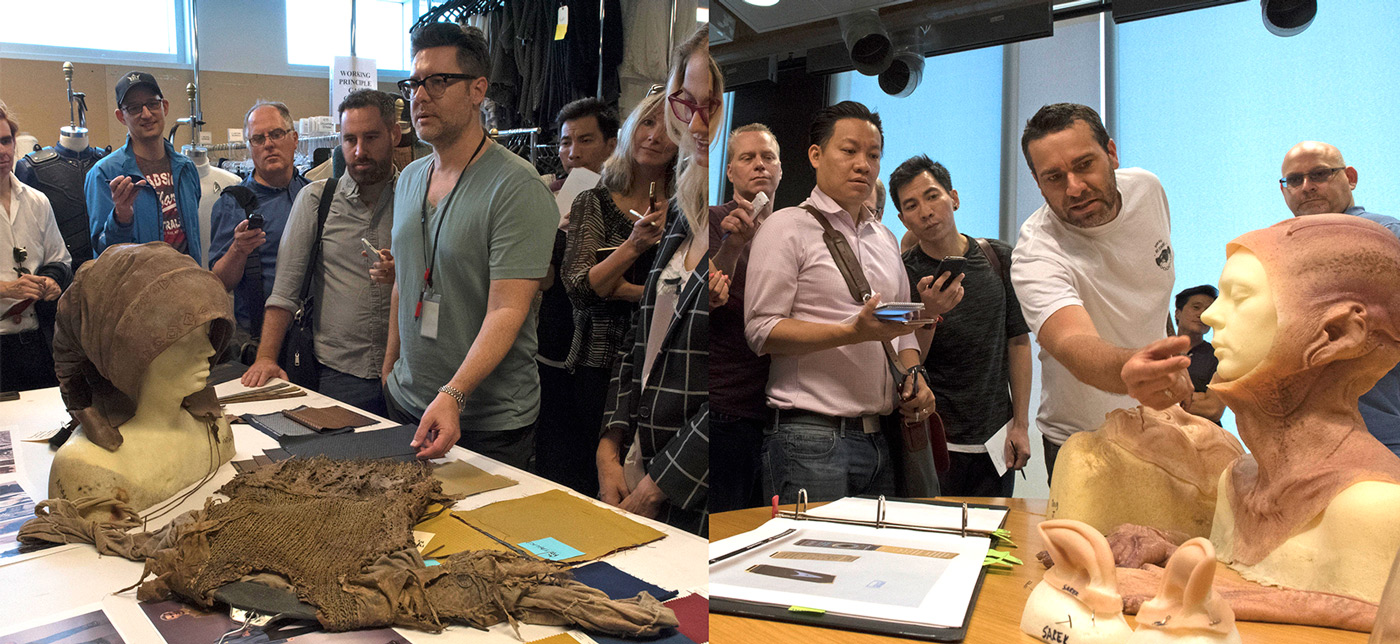
CNET has even more detail to share, especially about the technical aspects of the series’ sets and props — starting with a tidbit about a Klingon/Federation war status map that adorns Captain Lorca’s ready room wall:
Along the right wall of the ready room is a bank of flat-panel monitors… [with] a map of several planets with a red line dividing United Federation of Planets and Klingon Empire territories. Aaron Harberts, one of the showrunners of “Star Trek: Discovery”… says the line will change from episode to episode — a detail most viewers may not even catch.
And here’s some insight into the new capabilities about the Starfleet communicators, updated with video functionality:
The Discovery crew opted for a subtle update to the communicator using bits of gold and gray. They make it work by jamming Apple iPod Nanos inside of the flip-style communicators, says Sang Maier, who’s in charge of props for the show. He says the screen allows for the playback of images or video appropriate to any scene.
* * *
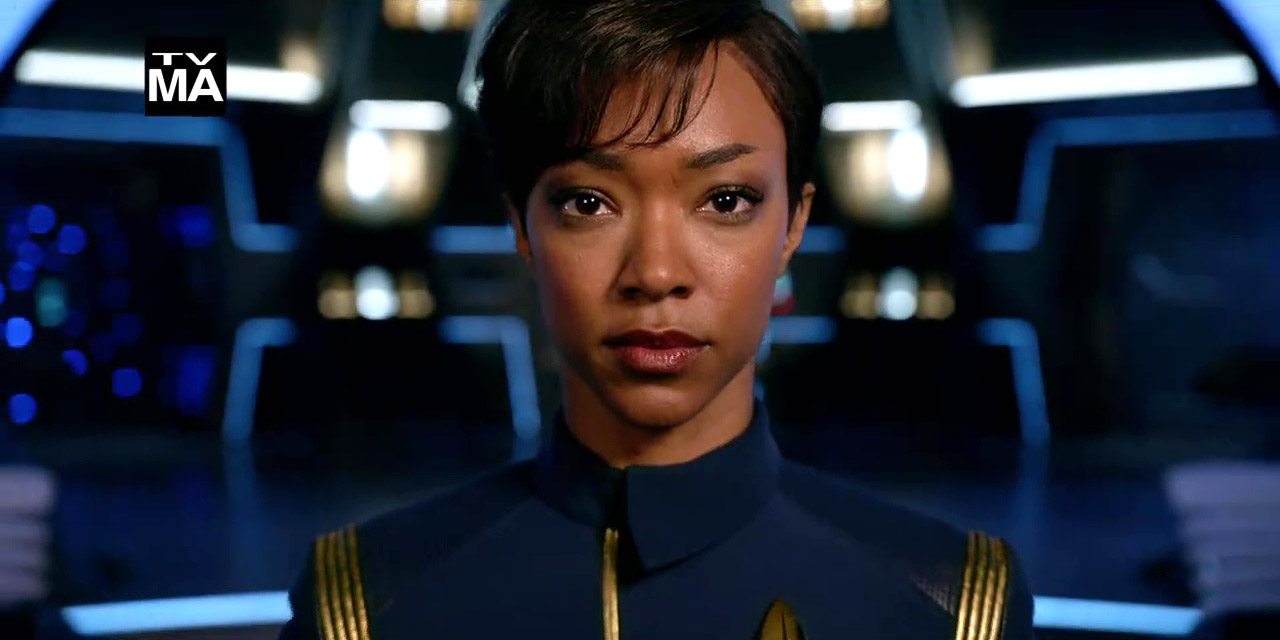
Finally, Sonequa Martin-Green spoke with StarTrek.com about how her character, Michael Burnham, assimilated into Vulcan culture after being raised by Sarek and Amanda after her parents were killed during her youth.
The idea of how Vulcan I am versus how human I am is one facet we’re exploring. Because there is this dichotomy of Vulcan indoctrination versus human emotion and human DNA, versus Starfleet ideology. And so, it’s really about all of these things, all of these tenets of my being, and how they are relating to each other, and how they’re opposing each other, right?
So, I was born into a human family, and a human life, and then was sort of forced into Vulcan culture. So, there’s the acculturation that has happened, and there was certainly the assimilation that I fought to achieve. And then you have Starfleet. And so almost, I feel as if Starfleet has provided a bridge for me between my humanity and my Vulcan upbringing.
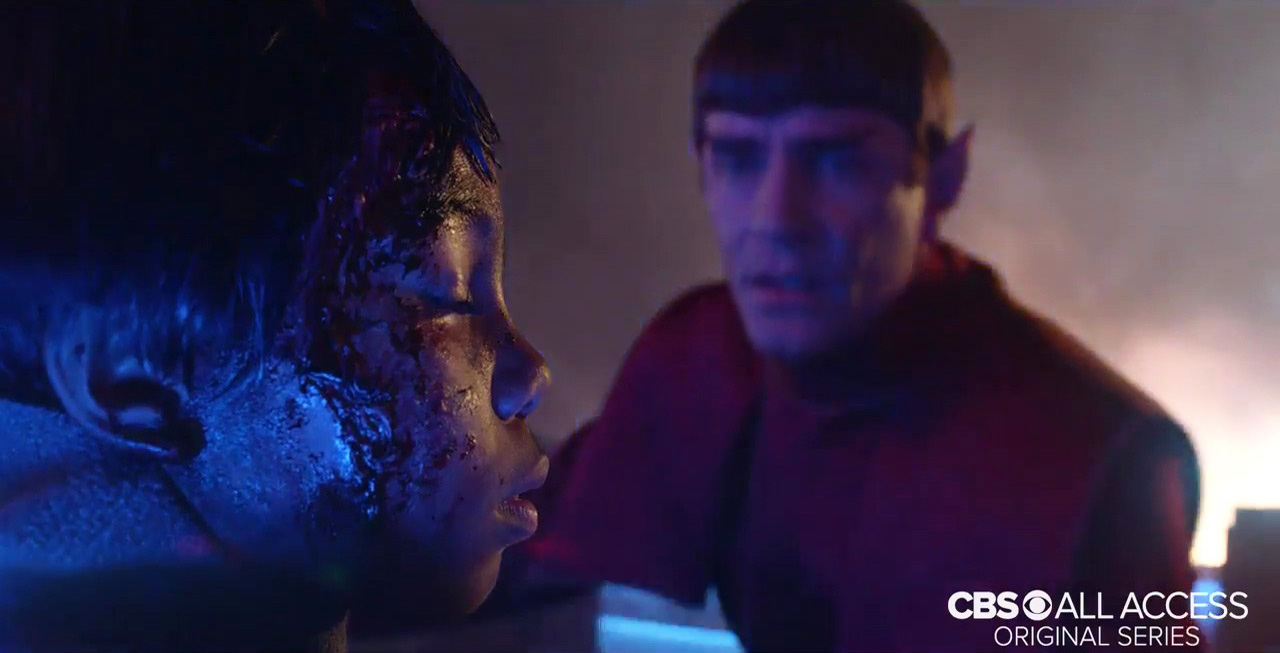
So, it’s interesting because it’s not the same journey as Spock. He, in his DNA, is Vulcan and human. But for me, it’s really about someone who attempted to become someone they were not born to be. Under tremendous pressure. Against insurmountable odds. (She’s) someone who’s succeeded in that to a point, and possibly to a fault.
So, there’s certainly that inner conflict, and a lot of the inner conflict has to do with that, because obviously there’s an identity crisis there, that, “Who am I? Who do I want to be? Who am I becoming, based on these decisions I’m making? Is it Vulcan logic, or is it human emotion that caused me to make that decision? I actually don’t know!”
![]()
Phew! That’s a lot of news for one Sunday evening – but keep checking back here at TrekCore for more Star Trek: Discovery updates as they arrive!

